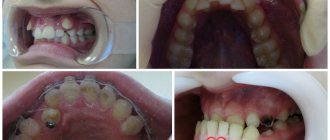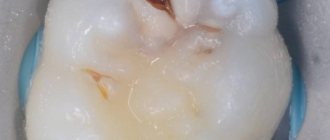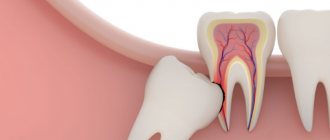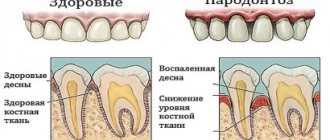A wedge-shaped tooth defect is a non-carious lesion, which is characterized by the formation of a wedge-shaped defect in the neck of the tooth. Such defects can appear on any teeth, but most often they occur on the canines, premolars (i.e. 3, 4, 5 teeth of the upper and lower jaw), less often - in the area of the anterior group of teeth. Wedge-shaped defects are always located only on the outer side of the teeth, which faces the lips or cheeks. The defects are wedge-shaped (steps).
Human teeth are very susceptible to developing wedge-shaped defects, and it is rare to meet a person who does not have them. In dentistry, the treatment of such defects, despite its apparent simplicity, is not an entirely simple task, because After treatment, fillings often fall out (below we will tell you what this is connected with), and patients have to go to the dentist again.
Wedge-shaped tooth defect: photo
If you look closely at the photographs, you will notice that wedge-shaped tooth defects have a smooth, shiny surface. Moreover, small defects (within the thickness of the tooth enamel layer) have the most common color, characteristic of the enamel of this patient’s teeth. And only if the lesion extends not only to the depth of the enamel, but also involves dentin, such defects have a pigmented surface.
If a wedge-shaped defect is formed, the symptoms are usually expressed in the appearance of moderate hypersensitivity of the teeth to various irritants (cold water or air, sweet or sour foods, as well as sensitivity to mechanical irritants - pain when brushing teeth). However, in some cases, the process can be asymptomatic, which is associated with the gradual deposition of replacement dentin from inside the pulp chamber, in which the neurovascular bundle of the tooth is located.
Wedge-shaped tooth defect: causes
It must be said that the term “wedge-shaped defect” exists as a separate disease only in Russian medicine, and describes only the geometric shape of tooth damage. Abroad, to classify such non-carious defects, terms are used that imply the reasons for their occurrence (for example, abfraction, abrasion, erosion).
Important: and believe me, this is not just a question of classification, but a question of why, when you treat wedge-shaped defects in Russia, all your fillings then fall out, plus the same defects appear in other teeth. The fact is that most doctors treat wedge-shaped defects, regardless of the cause of their appearance, by simply filling them. But in most cases this is not enough.
As you will see below: wedge-shaped dental defects, causes and treatment are very interconnected, and treatment in most cases should not only consist of a banal filling of the defect itself. There are 3 main reasons for the development of such defects.
Wedge-shaped defects of abfraction type –
Such wedge-shaped defects are also called abfraction defects. The root cause of the formation of wedge-shaped defects of this type is the incorrect relationship of the upper and lower teeth during their closure, which leads to the appearance of atypical types of load on the tooth. As a result of such a load, a so-called “bending stress” occurs in the cervical area of the tooth, accompanied by a piezoelectric effect (the essence of this process is that hydroxyapatite molecules push out calcium ions, which leads to the destruction of this area of enamel).
The second most important factor in the occurrence of defects of this type is the parafunction of the tongue (strong mechanical pressure of the tongue on the inner surface of the teeth), which occurs when the volume of the oral cavity is small, for example, with narrowed jaws, deep bite, etc.
The third most important factor is the presence of bruxism, in which there is an increased tone of the masticatory muscles, leading to an increase in the duration and force of pressure on the teeth when they are closed. All this also leads to the appearance of atypical loads on the tooth tissue, which is accompanied by destruction of the enamel.
Important: if you do not take into account the pathological occlusal interactions between antagonist teeth and simply fill the defect, the filling will inevitably fall out. This will happen because if incorrect contacts between the teeth are maintained and the pathological load on the tooth is maintained, “bending stress” will remain in the area of the tooth neck, which will lead to the destruction of the filling/tooth connection and the filling falling out.
Wedge-shaped defects of abrasive nature –
This type of wedge-shaped defect occurs in response to exposure of the tooth to abrasive materials. First of all, it should be said here about toothpastes (especially whitening ones), which have a very high RDA abrasiveness coefficient. Normally, adult toothpaste should have an RDA of 60-70, but most whitening toothpastes have significantly higher abrasiveness ratings.
Secondly, the reasons may be brushes with too hard bristles (medium is recommended), as well as incorrect teeth brushing technique. Under no circumstances should you make horizontal movements with a toothbrush along the front surface of the teeth; movements with the brush should only be sweeping.
Wedge-shaped defects of erosive nature –
In this case, the formation of defects is caused by chemical factors - acids contained in food, fruits and juices, and wine. Very often, wedge-shaped defects form in patients with gastritis and heartburn, because they constantly experience partial leakage of gastric juice into the oral cavity. Also, such defects often occur in people working in chemical production (24stoma.ru).
It is very important to know that after consuming acidic drinks and foods, it is not advisable to brush your teeth for the first hour (dental floss is fine). The fact is that acid washes calcium from the surface layer of enamel, making the enamel porous and less resistant to mechanical stress. It is necessary to wait about an hour until the enamel is partially remineralized by absorbing calcium ions contained in saliva.
Summary: it must be said that most wedge-shaped defects are formed precisely due to the process of abfraction (i.e., as a result of malocclusion, parafunction of the tongue or bruxism). However, you need to keep in mind that several factors can influence simultaneously. For example, as soon as you damage the enamel with highly abrasive whitening pastes, the acid factor immediately completes what it started (and vice versa).
In addition to the main ones, there are also predisposing factors -
- insufficient oral hygiene,
- the presence of soft and hard dental deposits,
- the presence of gingivitis or periodontitis,
- thyroid diseases,
- CNS diseases.
Bibliography
1. Sgolastra F, Petrucci A, Severino M, Gatto R, Monaco A. Lasers for the treatment of dentin hypersensitivity: a meta-analysis. J Dent Res. 2013 Jun;92(6):492-9.
2. Mahn E, Rousson V, Heintze S. Meta-Analysis of the Influence of Bonding Parameters on the Clinical Outcome of Tooth-colored Cervical Restorations. J Adhes Dent. 2015 Aug;17(5):391-403.
3. Marcelle M Nascimento, Deborah A Dilbone, Patricia NR Pereira, Wagner R Duarte, Saulo Geraldeli, and Alex J Delgado. Abfraction lesions: etiology, diagnosis, and treatment options. Clin Cosmet Investig Dent. 2016; 8: 79–87.
4. Miller PD Jr. A classification of marginal tissue recession. Int J Periodontics Restorative Dent 1985;5(2):8-13.
5. Zucchelli G, Gori G, Mele M, Stefanini M, Mazzotti C, Marzadori M, Montebugnoli L, De Sanctis M. Non-carious cervical lesions associated with gingival recessions: a decision-making process. J Periodontol. 2011 Dec;82(12):1713-24.
Wedge-shaped dental defect: treatment
If you or your dentist have discovered a wedge-shaped defect in your teeth, treatment will certainly consist primarily of restoring the integrity of the tooth. However, if you carefully read about the reasons for the development of such defects, then you will immediately understand that this alone is not enough. First of all, it is necessary to exclude the cause of the defect associated with improper contacts between the upper and lower teeth.
If you have several wedge-shaped defects (which indicates a large volume of the problem), then it is best to visit a good orthopedic dentist, because Only these doctors can perform high-quality selective grinding of teeth and normalize contacts between them. In addition, it is the orthopedic dentist (prosthetist) who will help you exclude other causes of the development of wedge defects, for example, with parafunction of the tongue and bruxism.
As for wedge-shaped defects of the abrasive and erosive types, in these cases the patient is selected hygiene products, taught the correct technique for brushing teeth, helped to decide on a diet, and, if necessary, is prescribed a consultation with an endocrinologist and gastroenterologist. Ideally, only after all this they begin to restore the integrity of the tooth.
When treating wedge-shaped defects, methods are used –
- filling of a wedge-shaped defect,
- grinding the contacts of antagonist teeth,
- fluoridation and remineralization therapy,
- sometimes – orthodontic treatment.
Treatment of small wedge-shaped defects –
Not deep wedge-shaped defects of small size (up to 0.5 mm) - usually there is no urgent need for filling. But if the doctor sees a high risk of rapid deepening of the defects, then they are filled with liquid-flowing composites, for example, “Flow It” or “Filtek Flow”. Liquid-flowing materials are used because they have high elasticity (but only with a material layer thickness of up to 0.5 mm). The high elasticity of the material makes it possible to partially compensate for the pathological occlusal load from antagonist teeth.
If the dentist says that filling can be delayed, then the emphasis in treatment should be on increasing the strength of the enamel to mechanical and chemical factors (but before that, again, you need to visit an orthopedic dentist and grind down the incorrect contacts between the antagonist teeth). What will you need to do to strengthen your teeth enamel...
Firstly, regular courses of remineralizing therapy with calcium-containing preparations, and secondly, fluoridation of tooth enamel (it is best to start doing both only after removing plaque from the dentist). It must be said that dental clinics use more effective drugs with higher concentrations of active components, but you can come up with something at home.
- Professional remineralization and fluoridation – one of the most effective drugs that allows for simultaneous remineralization + fluoridation is the drug “enamel-sealing liquid Tiefenfluorid” (made in Germany). This drug contains 2 components: the first component is highly active calcium hydroxide, the second is highly active fluorine. The components are applied to the teeth by the dentist one by one.
This product has only 1 disadvantage - its price. A more budget-friendly solution, but still quite effective, would be to treat teeth with fluoride varnish or fluoride gel (this will cost about 1,000 rubles). It will also be much more effective than home therapy, because... The fluoride concentration in the best medicated toothpastes is only 1,450 ppm, while the fluoride concentration in dental products is 20,000 ppm.
- Remineralization and fluoridation at home – there are semi-professional products that have a more or less good effect, but only with regular long-term use. A good effect can be achieved with the following combination of products. To brush your teeth 2-3 times a day, use your choice -
→ ROCS Medical Minerals remineralizing gel, → or PRESIDENT Unique toothpaste.These products contain large amounts of active calcium. After brushing your teeth, do not immediately spit out the foam, but hold it in your mouth for at least 1 more minute - this will allow more calcium ions to penetrate the enamel. After this, it is necessary to fix the calcium that has just penetrated there into the enamel using a fluoride rinse. We recommend choosing Elmex mouthwash (contains 250 ppm fluoride as amino fluoride) and rinsing your mouth for 1 minute.
Complications
There are two main complications: inflammation of the dental nerve and crown fracture. Both occur in the last stage of the disease, when the wedge-shaped defect reaches the pulp chamber. When the dental nerve is inflamed, the appearance of spontaneous paroxysmal night pain indicates the onset of pulpitis. Without treatment, it can progress to periodontitis. If a crown fracture occurs, there is a high probability of tooth extraction.
Due to a decrease in the quality of oral hygiene, plaque begins to accumulate on the teeth, which contributes to the development of caries, gingivitis, and later periodontitis, which in advanced cases can also lead to the removal or spontaneous loss of teeth.
Treatment of medium and large wedge-shaped defects
Treatment will consist of filling the wedge-shaped defect and, to be frank, filling such defects is still a big problem in dentistry.
Problem #1 – fillings fall out very quickly. Problem No. 2 – the filling quickly loses its aesthetics in places where it adheres to the hard tissues of the tooth (filling/tooth boundary). Of course, it should be noted that most dentists do not see this as a problem, and redo these fillings every year. Problems arise primarily from the fact that the dentist does not remove the traumatic factor (traumatic load on the tooth, i.e. abfraction), which leads to the persistence of “bending stress” in the cervical area of the tooth... That is. The solution to this problem is to correct everything that we wrote above in the section “Causes of wedge-shaped defects of the abfraction type.”
The second problem is the wrong choice of filling materials. Traditionally, the doctor’s choice here is possible only between two groups of materials: either glass ionomer cement or microphilic composites.
- Glass ionomer cements have advantages: they enter into a chemical bond with dental tissues, are less sensitive to moisture, and have satisfactory aesthetics (which is still significantly inferior to the aesthetics of composite materials).
Cons: high abrasion, discoloration, sensitive to dryness, mouth breathing (therefore, for example, they are not suitable for smokers). Studies have shown that as a result of overdrying, the area of the filling adjacent to the hard tissues of the tooth becomes covered with a small network of cracks, into which dyes then fall. Studies have also shown that exactly the same cracks form when a traumatic load from the antagonist tooth remains on the tooth. As a result, at the end of the first year of service, the filling becomes less aesthetically pleasing if it is located in the smile zone.
- Microphilic composites – advantages: they have very good aesthetics and resistance to wear. However, on the other hand, they are sensitive to moisture and have a very high polymerization shrinkage coefficient. In addition, if the dentist, again, has not eliminated the traumatic load when closing with the antagonist, cracks will also form in the filling made of this material at the border with the tooth tissues. But in general, this material is still slightly better than glass ionomer cements.
Important: however, there is a filling technique that will reduce the negative qualities of each material described. It's called the sandwich technique. Its meaning is that the lower part of the filling is made of glass ionomer cement, and the upper part is made of composite material. Today, this is the only possible way to make high-quality fillings when filling wedge-shaped defects of medium and large size. We hope that our article was useful to you!










